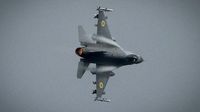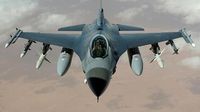As the conflict in Ukraine persists, the Ukrainian Air Force issued an urgent appeal to its citizens on March 21, 2025, urging them not to share videos of military aircraft, including F-16 jets, on social media. The statement emphasized that even brief clips could inadvertently provide critical intelligence to Russian forces, reflecting a significant concern in modern warfare: the unintended exposure of military operations through social media.
The urgency of this message highlights how both Ukrainian and Russian forces have experienced incidents where social media posts, often shared innocently or boastfully, have revealed the locations of troops, equipment, and hardware, resulting in dire consequences. “Even a few seconds of footage in the public domain might offer crucial data to the enemy,” remarked the press center in its Facebook post. This concern is particularly heightened as F-16 aircraft, recently delivered to Ukraine by its Western allies, symbolizes a pivotal advantage in the ongoing conflict.
Since February 2022, the onset of Russia's full-scale invasion saw a marked increase in content published on platforms such as Telegram, Twitter (now X), and TikTok, with wartime posts flowing from the front lines and digital spaces filled with visuals from both soldiers and civilians. While these posts can sometimes serve to bolster morale or counter enemy propaganda, they can also expose sensitive details, risking the safety of military personnel.
A recent incident exemplified these dangers. In January 2023, a Russian soldier’s social media activity inadvertently led to a successful strike by Ukrainian forces, where a geotagged post revealed their location in eastern Ukraine. Following this, Ukrainian forces attacked on January 20, destroying the targeted building. This incident demonstrated how easily a soldier's casual social media sharing could undermine operational security.
Unfortunately, Ukrainian forces have faced similar setbacks. In early 2022, a video on Telegram displayed Ukrainian soldiers operating a Bayraktar TB2 drone, yet the footage included recognizable landmarks. Subsequently, the area became a target for artillery fire as Russian forces geo-located the launch site. Such breaches of security have led to tighter regulations on social media use among military personnel.
Ukrainian Air Force spokesman Yuriy Ihnat commented on the dangers of information leaks, explaining, “One person films from one spot, another from a second spot, and a third from a third spot. This is called triangulation.” This statement captures the essence of how seemingly harmless social media posts can unwittingly paint a detailed picture of military movements.
The reliance on personal devices has become an operational hazard for both sides. During a shootout on New Year’s Day in 2023, the use of cell phones by Russian soldiers was suspected to be a contributing factor, as at least 89 soldiers died due to the pinpointing of their location through cellular signals, according to Russia’s Defense Ministry. On the Ukrainian front, the introduction of the F-16 jets intended for superior defense highlights a critical tactical upgrade yet opens avenues for risk as their operations remain intricately linked to digital exposure.
In August 2024, a TikTok video revealing an F-16 taking off from an undisclosed location played a role in compromising operational security as open-source intelligence tracked the specific location within hours. Although no evidence suggests Russia acted directly on this information, the incident prompted reinforced warnings from Ukrainian authorities that such leaks could lead to dangerous adjustments in enemy strategies.
Moreover, both combatants have exploited social media for misinformation campaigns intended to influence narratives. In February 2022, Russia put out a fabricated video portraying Ukrainian forces abandoning their posts during the Crimea annexation, while Ukraine at times has exaggerated its military victories through staged posts, such as one instance claiming an airstrike of a Russian Su-35 that turned out to be from a video game.
The shift resulting from social media's role in warfare has made it a focal point for gathering intelligence. “Social media has democratized intelligence gathering,” said Aric Toler, a Bellingcat researcher, indicating that raw footage disseminated rapidly impacts battlefield dynamics. The immediacy of updates through platforms like Telegram has led to significant risks associated with unfiltering vital wartime content.
A 2023 OECD study revealed that a substantial percentage of youth rely on social media as their primary news source. Such demographics globally consume unverified content that can warp perceptions of warfare. The ramifications of these digital leaks have been evident; for instance, a drone strike on a Russian airbase in Crimea in October 2022 was preceded by weeks of posts from Russian personnel showing the deployment of aircraft within geolocated proximity, which aided Ukrainian planning.
On the flip side, there are instances where Ukrainian posts have guided Russian forces in targeting assaults, such as a video showing downed Ukrainian missiles that subsequently precipitated an intense barrage against the area. Consequently, both sides are striving to adapt while addressing the challenges posed by modern connectivity.
To adeptly respond to these emerging threats, Russia has instituted severe repercussions for soldiers found guilty of mobile use in combat zones, while Ukraine has favored public campaigns and internal crackdowns to reinforce operational security. “We’re asking civilians to think like soldiers,” Ihnat reported, reflecting the challenge of educating a populace equipped with smartphones.
Looking ahead, the balance between transparency on social media and critical operational security remains precarious. For Ukraine, the F-16s signify a strategic benefit bolstered by international support; meanwhile, for Russia, every exposed detail cultivates an opportunity to reclaim a strategic advantage. As combatants operate in a landscape defined by connectivity, the consequences of digital interactions will continue to shape the dynamics of this ongoing conflict.
The Ukrainian Air Force’s public plea serves as a crucial reminder that in this era of immediate connectivity, every post can resonate through battlefields, altering lives and determining the outcomes of pivotal military operations.






